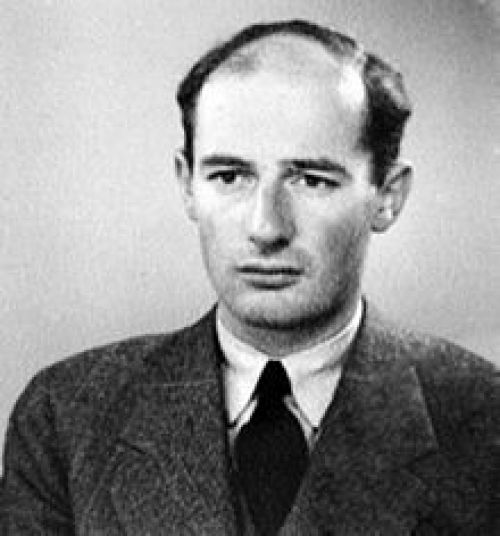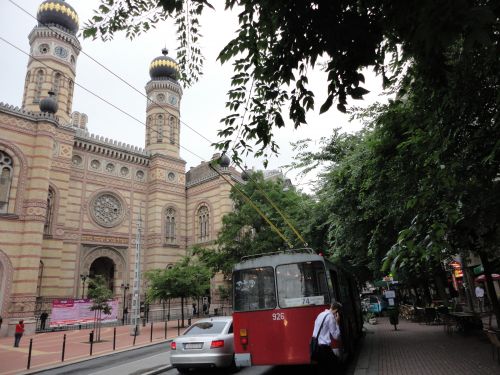Raoul Wallenberg

Raoul Wallenberg - Passport photograph from 1944 (Private Archives)
Raoul Wallenberg was born on 4th August 1912, in Lidingo, near Stockholm, Sweden. He was born into a distinguished family of bankers, diplomats and officers; his father was Raoul Oscar Wallenberg, and his mother was Maria 'Maj' Sofia Wising. His father died before he was born, was an officer in the Swedish navy. Raoul Wallenberg grew up in the house of his stepfather Frederik von Dardell. He studied architecture in the United States of America, but then took up a career in banking and international trade, which brought him to Haifa in Israel, for a six months' stay during 1936.
On the recommendation of the Swedish branch of the World Jewish Congress and with the support of the American War Refugee Board, the Swedish Foreign Ministry, in July 1944, sent Raoul Wallenberg to Budapest, in order to protect over 200,000 Jews who were left in the Hungarian capital after the deportation of 437,000 Hungarian Jews to Auschwitz-Birkenau Concentration Camp.
The Swedish legation in Budapest initiated its operation on behalf of the persecuted Jews a short while after the German occupation of Hungary on March 19, 1944. At that time Adolf Eichmann, and a special commando under him, together with the Hungarian authorities, began organising the deportation of the Jews to their deaths in the gas chambers in Birkenau. The Swedish Foreign Minister, Ivar Danielsson, had proposed giving provisional Swedish passports to Hungarian Jews who had family ties or commercial connections with Swedish citizens.
By the time Wallenberg arrived in Budapest, several hundred such 'protective passports' had been issued. His arrival on July 9, 1944, coincided with the cessation of the deportations, a decision taken by the Hungarian government as a result of international pressure, including intervention by King Gustav V of Sweden.
The protective operation carried out by the Swedish legation, in conjunction with other diplomatic missions, was nevertheless maintained, and Wallenberg, the new legation attaché, was put in charge of a section created expressly for this purpose. Before taking up his post he had been given special authority, at his request, for certain arrangements to be left in his hands, such as the transmission of funds by means of the War Refugee Board - which in turn received money from Jewish organisations in the United States of America.
Budapest Synagogue 2011 (Chris Webb)
A coup d'état took place on October 15, 1944, and the anti-Semitic fascist Arrow Cross Party, headed by Ferenc Szalasi, seized power in the country. The Jews in Budapest were now in mortal danger, both from the Arrow Cross murder actions and from deportations organised by Eichmann and his commando. From that moment on, Wallenberg displayed great courage and heroism in the rescue missions he undertook. Over the course of three months he issued thousands of 'protective passports.' Most of the time the Hungarian authorities and the Germans honoured the signature of the Swedish legation, and the 'protective passports' afforded protection for many Jews.
When Adolf Eichmann organised the 'Death Marches' of thousands of Jews to the Austrian border on November 8, 1944, to the reception camp at Strasshof, near Vienna, Raoul Wallenberg pursued the marching thousands in his car and managed to secure the release of hundreds of bearers of such 'protective passports' and take them back to Budapest. His impressive and self-assured manner enabled him to remove persons from the trains bound for Auschwitz or to release them from the Labour Service System into which they had been drafted.
The Jews were also in danger of being killed by Arrow Cross men, and to prevent this, Wallenberg set up special hostels accommodating some 15,000 persons, in an operation in which other diplomatic missions were also involved, by issuing protective documents of their own. There were thirty-one 'protected houses' which together formed the 'international ghetto,' a separate entity, apart from the main ghetto. The management of these houses posed many complicated problems, since it involved the provision of food, as well as sanitation and health services, all requiring a great deal of money: as many as six hundred Jewish employees were engaged in the administration and upkeep of these houses.
Both the 'international ghetto' and the main ghetto were located in Pest, which was the first part of Budapest to be occupied by the Red Army. Wallenberg made efforts to negotiate with the Soviets and to ensure proper care for the liberated Jews. The Soviets were highly suspicious of the Swedish mission and charged its staff for spying for the Germans. The large number of Swedish documents in circulation also raised doubts in the minds of the Soviets. When the Soviets requested that Raoul Wallenberg to report to their army headquarters in Debrecen, Wallenberg must have believed that he would be protected by his diplomatic immunity, especially since the Swedish legation had represented Soviet interests with the Germans, and he made his way to the Soviet headquarters.
He returned to Budapest on 17th January 1945, escorted by two Soviet soldiers, and was overheard saying that he did not know whether he was a guest of the Soviets or their prisoner. Thereafter, all trace of Raoul Wallenberg and his driver Vilmos Langfelder were lost. The other staff members of the Swedish legation were also held by the Soviets, but within a few months they all returned to Stockholm, via Bucharest and Moscow.
In the first few years following Wallenberg's disappearance the Soviets claimed that they had no knowledge of a person named Wallenberg and were not aware that a person of that name was being held in any of their prisons. German Prisoners of War, however, coming back from Soviet imprisonment, testified that they had met Wallenberg in prisons and camps in various parts of the Soviet Union. During the mid-1950's, on the basis of these accounts, the Swedish government submitted a strong demand to the Soviets for information on Wallenberg, to which the Soviets replied in 1956, that they had discovered a report of Wallenberg's death in 1947, in a Soviet prison. Wallenberg's family, and especially his mother, did not accept this claim, which conflicted with testimonies from other sources.
As the years went by, public opinion in Sweden, and all over the world, became increasingly critical of the manner in which the Swedish government had handled the issue. The subject of Wallenberg came up time and time again, and with even greater force after the death of his mother in 1979. Books were published about Wallenberg and public committees were set up to deal with the case, especially in the United Kingdom, the United States of America and Israel. The reports that were published revealed that in the final days of Nazi occupation of Budapest, Wallenberg with the help of Hungarians and the Jewish Council was able to foil a plot by the SS and Arrow Cross, to blow up the ghettos before the city's impending liberation by the Soviet forces. Through this act, some 100,000 Jews were saved in the two ghettos.
In recognition of this rescue mission by Wallenberg, the United States of America Congress awarded him honorary American citizenship. Memorial institutions were created in his honour, streets were named after him and films were produced about his work in Budapest. Wallenberg's name and reputation as a 'Righteous Among the Nations' has become a legend.
Sources:
Encyclopedia of the Holocaust - Israel Gutman (Ed) - New York 1990.
G. Reitlinger, The Final Solution, published by Sphere Books Ltd, London 1971
Photographs - Private Archives and Chris Webb Archive
© Holocaust Historical Society 2018


